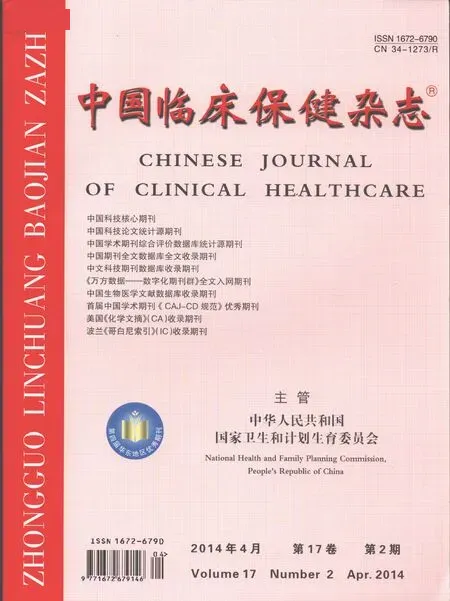血尿酸水平与冠心病慢性心功能不全的相关性
2014-06-05朱长琪杨静孟令毅夏家栋
朱长琪,杨静,孟令毅,夏家栋
(安徽合肥市第一人民医院急诊内科,230061)
血尿酸水平与冠心病慢性心功能不全的相关性
朱长琪,杨静,孟令毅,夏家栋
(安徽合肥市第一人民医院急诊内科,230061)
目的探讨血尿酸水平和冠心病慢性心功能不全的关系。方法将296例冠心病患者分为两组:心功能正常组173例,心功能不全组123例,心功能不全组按纽约心脏病学会NYHA分级分为心功能Ⅱ级组(n=31),心功能Ⅲ级组(n=40),心功能Ⅳ级组(n=52)。应用尿酸氧化酶法测定血尿酸浓度。结果①心功能正常组血尿酸浓度(330.62±89.21)μmol/L,高尿酸血症发生率21.97%;心功能不全组血尿酸浓度(415.63±100.30)μmol/L,高尿酸血症发生率50.41%(P<0.01)。②心功能Ⅱ级亚组血尿酸浓度(362.37 ±101.01)μmol/L,高尿酸血症发生率25.81%;心功能Ⅲ级亚组血尿酸浓度(389.12±100.37)μmol/L,高尿酸血症发生率35.00%;心功能Ⅳ级亚组血尿酸浓度(427.21±98.33)μmol/L,高尿酸血症发生率82.69%;各组间血尿酸水平差异有统计学意义(P<0.05)。结论冠心病慢性心功能不全患者血尿酸水平升高,血尿酸水平与心功能不全的严重程度呈正相关。
冠心病;尿酸;危险因素
冠心病(CHD)是目前造成人类死亡的主要疾病之一。冠状动脉粥样硬化(AS)是其病理基础。而炎症在冠状动脉粥样硬化的发生和发展中起着非常重要的作用[1]。随着病程的进展,冠心病患者往往伴有心力衰竭症状,临床发现该类患者多同时伴随有血尿酸水平的升高。流行病学的研究表明慢性心力衰竭患者血清尿酸水平升高是疾病恶化及死亡率增加的一个危险因素[2]。本文旨在通过对不同心功能状态冠心病患者血清尿酸浓度的分析,探讨血清尿酸水平与冠心病慢性心功能不全的关系。
1 资料与方法
1.1 一般资料 选择2009年3月至2012年10月在合肥市第一人民医院住院的296例确诊冠心病患者,分为2组,心功能正常组共173例,男性103例,女性70例,年龄45~83岁,平均(63.1±3.2)岁;心功能不全组共123例,男性92例,女性31例,年龄52~81岁,平均(65.1±4.3)岁;所有心功能不全的患者均符合Framingham心力衰竭诊断标准,其心功能按照纽约心脏病学会NYHA分为Ⅱ~Ⅳ级,根据心功能状况再分为三个亚组,入选的所有患者排除重度肥胖、糖尿病、痛风、肾功能不全及已经使用利尿剂的患者。见表1。

表1 按心功能不全分组情况
1.2 方法 患者均空腹12 h后采集静脉血,在全自动生化分析仪应用尿酸氧化酶法测定血尿酸浓度,正常参考值为男性210~420μmol/L,女性150~370μmol/L。
1.3 统计学处理 采用SPSS13.0统计软件包。计量资料用±s表示,各组间采用F检验和t检验。
2 结果
2.1 冠心病心功能正常组与心功能不全组血清尿酸浓度、高尿酸血症(HUA)发生率的比较 冠心病心功能正常组与心功能不全组血清尿酸浓度差异有统计学意义[(330.62±89.21)μmol/L比(415.63 ±100.30)μmol/L,P<0.01]。冠心病心功能不全组HUA发生率明显高于冠心病心功能正常组(50.41%比21.97%),P<0.01。
2.2 冠心病心功能不全组不同心功能分级亚组患者血清尿酸浓度、HUA发生率的比较 冠心病心功能不全组不同心功能分级亚组患者血清尿酸浓度差异有统计学意义(P<0.05)。不同心功能分级患者HUA发生率差异有统计学意义(P<0.05),随着患者心功能不全的程度加重,HUA发生率显著升高,见表2。
3 讨论
尿酸(UA)是人体内外源性(饮食)和内源性嘌呤代谢的最终产物。血尿酸水平受到尿酸代谢、嘌呤代谢、某些疾病及药物等多种因素的影响,同样也受到遗传及生活方式影响[3]。1951年Gertler等[4]首次提出尿酸与心血管疾病是有相关性的。此后多个前瞻性研究均显示基础尿酸水平与心血管疾病的发生及死亡率相关[5]。

表2 冠心病心功能不全组不同心功能分级亚组患者血清尿酸浓度和HUA比较
综合本研究资料,冠心病组血尿酸水平明显高于对照组,差异有统计学意义;冠心病患者随着心功能的恶化其尿酸水平亦有升高的趋势。提示血尿酸水平与冠心病心功能不全的严重程度相关。因此检测血尿酸水平有助于评估冠心病心功能不全患者的预后,为临床提供一个有意义的生化指标,可作为心功能恶化的预测指标。对血尿酸的有效控制可减低心血管事件的发生率及死亡率,对于提高冠心病心功能不全患者的远期预后无疑具有重要意义。但是高尿酸血症是冠心病的伴随现象还是独立危险因素还需进一步研究,并从病理生理方面进行证实。
[1] Taniguchi H,Momiyama Y,Ohmori R,et al.Associations of plasma C-reactive protein levels with the presence and extent of coronary stenosis in patientswith stable coronary artery disease[J].Atherosclerosls,2005,178(1):173-177.
[2] Leyva F,Anker SD,Godsland IF,et al.Uric acid in chronicheart failure:a maker of chronic in inflammation[J].Eur Heart J,1998,19(12):1814-1822.
[3] Doherty M.New insights into the epidemiology of gout[J].Rheumatology(Oxford),2009,48(Suppl 2):112-118.
[4] Gertler MM,Garn SM,Levine SA.Serum uric acid in relaion to age and physique in health and in coronary heart disease[J].Ann Intern Med,1951,34(6):1421.
[5] Hayden MH,Tyagi SC.Uric acid:A new look at an old risk.maker for cardiovascular disease,metabolic sysdrome,and 2 diabetes metllitus:the urate redox shuttle[J].Nutr Metab,2004,(1):10.
Correlation between serum uric acid and chronic cardiac insufficiency of patientswith coronary heart disease
ZHU Changqi,YANG Jing,MENG Lingyi,XIA Jiadong(Department of Emergence,the Frist People’s Hospital of Hefei,Hefei230061,China)
ObjectiveTo investigate the relationship between serum uric acid and chronic cardiac insufficiency of patientswith coronary heart diseases.MethodsPatients with coronary heart diseases were divided into 2 groups:normal cardiac function group(173cases)and cardiac dysfunction group(123cases).According to the New York Heart Association(NYHA)criteria,a total of 173 cardiac dysfunction patients were divided into Group NYHAⅡ(n=31),Group NYHAⅢ(n=40),Group NYHAⅣ(n=52),The levelof SUA wasmeasured with urate oxidase method.Results(1)Themean SUA level in normal cardiac function group was(330.62±89.21)μmol/L,and the total incidence of hyperuricemia(HUA)was21.97%.Themean SUA level in cardiac dysfunction group was(415.63 ±100.30)μmol/L,and the total incidence of HUA was 50.41%.(2)Themean SUA level in patients with NYHAⅡ,NYHAⅢ,NYHAⅣwas(362.37±101.01)μmol/L,(389.12±100.37)μmol/L,and(427.21±98.33)μmol/L respectively,and the incidences of HUA were 25.81%,35.00%,and 82.69%respectively.There was significant difference in SUA among these groups(P<0.05).ConclusionThemean SUA level in patients with cardiac dysfunction is higher than patients with normal cardiac function.There is a positive correlation between the level of SUA and the severity of cardiac dysfunction.
Coronary disease;Uric acid;Risk factors
R541.4
A
10.3969/J.issn.1672-6790.2014.02.015
2013-03-20)
朱长琪,副主任医师,Email:619148227@qq.com
